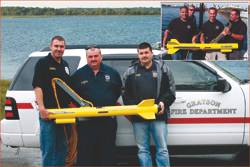More Public Safety Dive Teams Employ Side Scan Sonar
More public safety dive teams are adding sonar to assist in their underwater search and recovery operations.
Side scan is the ideal tool for these operations because it produces detailed images of the underwater environment regardless of water clarity. In addition, the sonar is able to search large areas quickly, scanning several hundred feet of ocean, lake, or river bottom with each pass of the boat. The sonar does this by transmitting an acoustic beam from a towfish which sweeps the bottom and reflects off any objects lying there. The reflected beam returns to the fish and is sent topside where vivid color images are displayed and stored on a notebook computer. Connecting a GPS allows position coordinates to be captured with the sonar data. Side scan can easily locate a variety of targets including sunken boats, submerged vehicles, and drowning victims. An optional Splashproof computer with ultrabright display can be an essential item when operating from a small, open boat.
One team that recently acquired a side scan is Grayson Fire Department in Kentucky. The department serves an area covering 90 square miles. Their dive team is responsible for search and recovery missions in 20 mile long Grayson Lake and surrounding waterways, where tragically 2 to 3 persons drown each year. To assist in searching such a large area, the team decided a side scan sonar would be a great asset. With support from the community and assistance from New Horizons Dive Shop, the team raised the necessary funds and purchased a sonar. The one they chose was JW Fishers SSS-600K side scan because it would give them the optimal combination of range and resolution. With five different range settings providing varying resolution, the 600K lets the operator tailor the system’s operation to meet the mission requirements. On the long range setting the sonar is capable of scanning a swath up to 200 feet wide on each side of the boat, most helpful when searching large areas. This setting is best when looking for bigger targets like a car that has gone off a bridge or a capsized pleasure craft. When looking for small or soft targets such as a drowning victim, shorter range settings are a better choice. After completing a one day training session at Fishers factory team members returned home, and two days later they were out on Grayson Lake practicing with their new sonar. Lt. Kyle Morgan reported, “We can clearly see tires, lots of tree limbs, and several cinder blocks on the bottom. The images were quite impressive.”
Two more departments that have added Fishers side scan sonars are the Iberville Parish Sheriffs Office in Louisiana and the New Bedford Police Department in Massachusetts. Iberville Parish is located just south of Baton Rouge and includes 34 square miles of water, much of it bayou. The sheriffs department went with the single frequency SSS-600K as it has all the range needed to work in small bodies of water, but also the high resolution needed to find small targets like drowning victims and weapons. Along with the sonar system they opted for the mapping software which shows the track of the boat as it runs a search grid and the size of the sonar swath, ensuring no part of the area is missed. New Bedford is a coastal city with an active port and small airport. The police chose the dual frequency SSS-100K/600K side scan which provides both detailed images of high frequency combined with the longer scanning range of low frequency, an essential feature when searching large areas of open ocean looking for lost vessels or downed aircraft. An adjustable transducer feature is available with the single frequency that allows the sonar to scan vertical structures making it an excellent tool to inspect ship’s hulls for compartments carrying drugs, or scan piers and bulkheads for explosives. After completing the training session Sgt. Jill Simmons, a longtime member of the department’s port security team reports “I’m very happy with the unit, and the guys loved it! Our group was already using Fishers TOV-1 towed video system and Pulse 8X metal detector and getting good results. When we got the funding for a side scan, their system was the obvious choice.”
A few more of the many teams using Fishers side scan sonars are the Lowndes County Sheriffs Department in Georgia, the Oxnard Fire Department in California, the Aronac County Sheriffs Department in Michigan, the Livingston Parish Office of Homeland Security in Louisiana, the Pulaski County Sheriffs Office in Arkansas, and the National Search and Rescue Agency of Indonesia.











